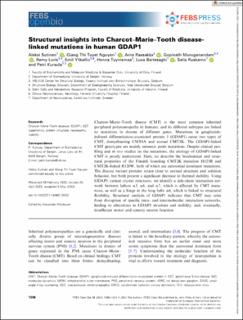Structural insights into Charcot–Marie–Tooth disease-linked mutations in human GDAP1
| dc.contributor.author | Sutinen, Aleksi | |
| dc.contributor.author | Nguyen, Giang Thi Tuyet | |
| dc.contributor.author | Raasakka, Arne | |
| dc.contributor.author | Muruganandam, Gopinath | |
| dc.contributor.author | Loris, Remy | |
| dc.contributor.author | Ylikallio, Emil | |
| dc.contributor.author | Tyynismaa, Henna | |
| dc.contributor.author | Bartesaghi, Luca | |
| dc.contributor.author | Ruskamo, Salla | |
| dc.contributor.author | Kursula, Petri | |
| dc.date.accessioned | 2023-03-15T12:25:05Z | |
| dc.date.available | 2023-03-15T12:25:05Z | |
| dc.date.created | 2022-09-20T12:28:16Z | |
| dc.date.issued | 2022 | |
| dc.identifier.issn | 2211-5463 | |
| dc.identifier.uri | https://hdl.handle.net/11250/3058395 | |
| dc.description.abstract | Charcot–Marie–Tooth disease (CMT) is the most common inherited peripheral polyneuropathy in humans, and its different subtypes are linked to mutations in dozens of different genes. Mutations in ganglioside-induced differentiation-associated protein 1 (GDAP1) cause two types of CMT, demyelinating CMT4A and axonal CMT2K. The GDAP1-linked CMT genotypes are mainly missense point mutations. Despite clinical profiling and in vivo studies on the mutations, the etiology of GDAP1-linked CMT is poorly understood. Here, we describe the biochemical and structural properties of the Finnish founding CMT2K mutation H123R and CMT2K-linked R120W, both of which are autosomal dominant mutations. The disease variant proteins retain close to normal structure and solution behavior, but both present a significant decrease in thermal stability. Using GDAP1 variant crystal structures, we identify a side-chain interaction network between helices ⍺3, ⍺6, and ⍺7, which is affected by CMT mutations, as well as a hinge in the long helix ⍺6, which is linked to structural flexibility. Structural analysis of GDAP1 indicates that CMT may arise from disruption of specific intra- and intermolecular interaction networks, leading to alterations in GDAP1 structure and stability, and, eventually, insufficient motor and sensory neuron function. | en_US |
| dc.language.iso | eng | en_US |
| dc.publisher | Wiley | en_US |
| dc.rights | Navngivelse 4.0 Internasjonal | * |
| dc.rights.uri | http://creativecommons.org/licenses/by/4.0/deed.no | * |
| dc.title | Structural insights into Charcot–Marie–Tooth disease-linked mutations in human GDAP1 | en_US |
| dc.type | Journal article | en_US |
| dc.type | Peer reviewed | en_US |
| dc.description.version | publishedVersion | en_US |
| dc.rights.holder | Copyright 2022 The Author(s) | en_US |
| cristin.ispublished | true | |
| cristin.fulltext | original | |
| cristin.qualitycode | 1 | |
| dc.identifier.doi | 10.1002/2211-5463.13422 | |
| dc.identifier.cristin | 2053470 | |
| dc.source.journal | FEBS Open Bio | en_US |
| dc.source.pagenumber | 1306-1324 | en_US |
| dc.identifier.citation | FEBS Open Bio. 2022, 12 (7), 1306-1324. | en_US |
| dc.source.volume | 12 | en_US |
| dc.source.issue | 7 | en_US |
Tilhørende fil(er)
Denne innførselen finnes i følgende samling(er)
-
Department of Biomedicine [710]
-
Registrations from Cristin [9791]

